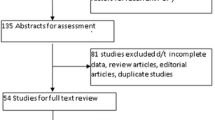Conclusions
The average life span of women in the Western world is currently about 80 years, and is gradually increasing. Hence prolapse is likely to increase. Although the last two decades have shown improved techniques in the management of prolapse, the Cochrane Collaboration criticizes a serious lack of randomized controlled trials of new interventions. Several procedures have been mentioned only briefly in this chapter because little objective data were available. It is hoped that in the next decade more objective studies including comparative results will be published.
Access this chapter
Tax calculation will be finalised at checkout
Purchases are for personal use only
Preview
Unable to display preview. Download preview PDF.
Similar content being viewed by others
References
Baessler K, Schuessler B (2001) Abdomino sacro colpopexy and anatomy and function of the posterior compartment. Obstet Gynecol 97:678–684.
Brubaker L, Bump R, Jacquetin B, Schuessler B, Weidner A, Zimmern P, Milani R (2002) Pelvic organ prolapse. In: Abrams P, Cardozo L, Khoury S, Wein A (eds) Incontinence, Second International Consultation on Incontinence. Health Publication, Plymbridge Distributors, Plymouth UK, Chapter 5, pp 243–266.
Clemens JL, Aguilar VC, Tillinghast TA, Jackson ND, Myers DL (2003) Risk factors associated with an unsuccessful pessary fitting trial in women with pelvic organ prolapse. Neurourol Urodyn 22:648–653.
Dwyer PL, O’Reilly BA (2004) Trans vaginal repair of anterior and posterior compartment with Atrium polypropylene mesh. Brit J Obstets Gynaecol 111:831–836.
Grody MHT (2003) Posterior compartment defects. In: Rock JA, Jones HW (eds) Te Linde’s operative gynecology 9th edn. Lippincott William & Wilkins, Philadelphia, pp 966–985.
Hung, MJ, Liu FS, Shen et al (2004) Factors that affect recurrence after anterior colporrhaphy procedure reinforced with four-corn anchored polypropylene mesh. Int Urogynecol J 15:399–400.
Jeffcoate TNA (1959) Posterior colporrhaphy. Am J Obstet Gynecol 77:490.
Kohli N, Sze EHM, Roat TW, Karram MM (1996) Incidence of recurrent cystocoele after anterior colporrhaphy with and without concomitant transvaginal needle suspension. Am J Obstet Gynecol 175:1476–1482.
Lovatsis D, Drutz HP (2002) Safety and efficacy of sacrospinous vault suspension. Int Urogynecol J 13:308–313.
MacLennan AH, Taylor AW, Wilson DH, Wilson D (2000) The prevalence of pelvic floor disorders and their relationship to gender, age, parity and mode of delivery. Br J Obstet Gynaecol 107:1460–1470.
Maher C, Baessler K, Glazener CMA, Adams EJ, Hagen S (2004) Surgical management of pelvic organ prolapse in women. Cochrane Library, Issue 4, Article number CD004014.pub2.
Milani R, Salvatore S, Soligo M, Pifarotti P, Meschia M, Cortese M (2005) Functional and anatomical outcome of anterior and posterior vaginal prolapse repair with prolene mesh. BJOG 112:107–111.
Nichols DH, Randall CL (1996) Vaginal surgery 4th edn. Williams and Wilkins, Baltimore, pp 258–283.
Shull B (2003) Paravaginal defect repair; Surgical correction of defects in pelvic support. In: Rock JA, Jones HW (eds) Te Linde’s operative gynecology 9th edn. Lippincott William & Wilkins, Philadelphia, Chapter 35, pp 957–962.
Shull BL, Capen CV, Riggs MW, Kuehl TJ (1992) Preoperative and postoperative analysis of site-specific pelvic support defects in 81 women treated with sacrospinous ligament suspension and pelvic reconstruction. Am J Obstet Gynecol 166:1764–1171.
Te Linde’s operative gynaecology (2003) 9th edn. Lippincott Williams and Wilkins, Philadelphia.
Valaitis SR, Stanton SL (1994) Sacrocolpopexy: a retrospecture study of a clinician’s experience. Br J Obstets and Gynaecol 101:518–522.
Weber AM, Walter MD (1997) Anterior vaginal prolapse: Review of anatomy and techniques of surgical repair. Obstet Gynecol 89:311–318.
Weber AM, Walters MD, Piedmaont MR, Ballard LA (2001) Anterior colporrhaphy: A randomized trial of three surgical techniques. Am J Obstet Gynecol 185:1299–1304.
Rights and permissions
Copyright information
© 2006 Springer-Verlag London Limited
About this chapter
Cite this chapter
(2006). Management of Prolapse. In: Urogynecology: Evidence-Based Clinical Practice. Springer, London. https://doi.org/10.1007/1-84628-165-2_10
Download citation
DOI: https://doi.org/10.1007/1-84628-165-2_10
Publisher Name: Springer, London
Print ISBN: 978-1-84628-164-8
Online ISBN: 978-1-84628-165-5
eBook Packages: MedicineMedicine (R0)




